RULES FOR REDEMPTION PAMPHLET
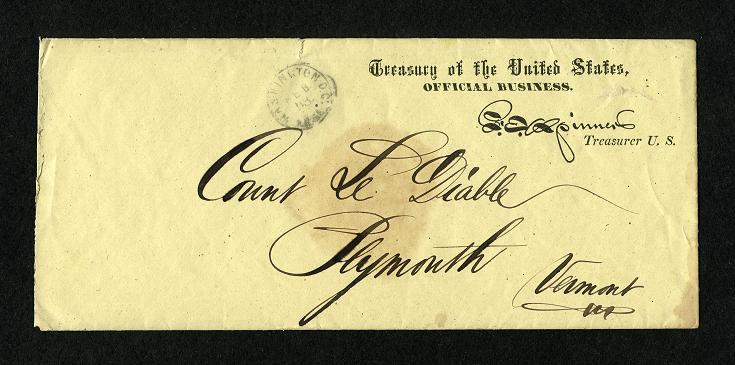

I was recently able to pick up a free-frank envelope that was addressed to Count Le Diable in Plymouth, Vermont that was written entirely in Spinner's handwriting. His destinctive signature and script is easily recognized by his use of his famous three-nibbed pen. Inside the envelope is a pamphlet on the Rules for Redemption of fractional currency and was dated Beb. 13, 1869. This pamphlet consists of four pages and these redemption rules are a very scarce item. This copy is in excellent condition and contains an additional Spinner signature.
The envelope is also in excellent condition. Besides the distinctive script on the cover, it was also opened by a cut along its left border that protected and perserved the red was seal on the reverse. This red wax seal has the motif of an eagle and also the words "Treasury United States, Redemption Division". This seal is pictured below. Click on any item to enlarge scan.
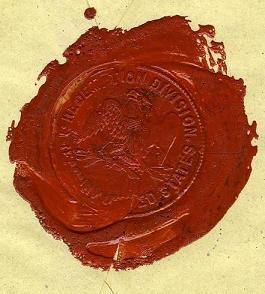
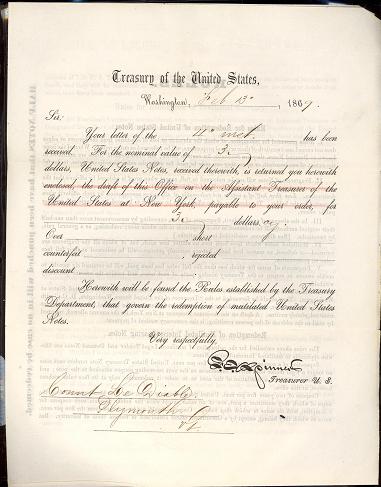
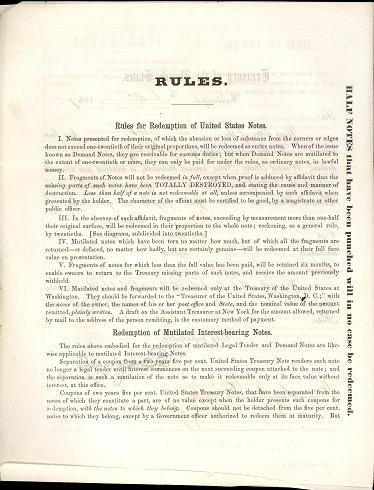
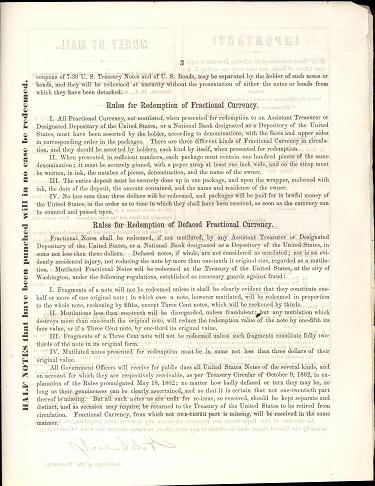
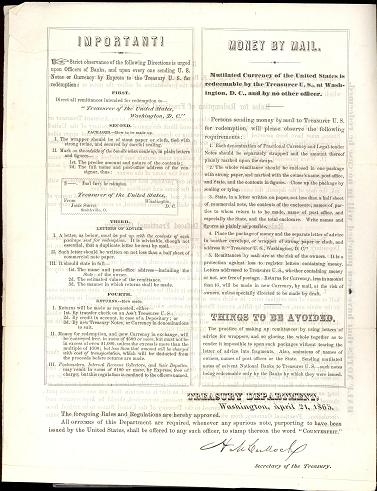
NEW VARIETY OF A COUNTERFEIT NOTE UPDATED 2022
Fractional notes were highly counterfeited during the 1860's and into the 1870's. With fractional currency, the production of all five different issues and all their varieties were done to try to thwart the production of spurious notes. As fast as the government printing came up with a solution, counterfeiters were already making and passing new counterfeit currency. One of the most counterfeited variety was the 1st issue fifty cent note. The FR1312 has at least nineteen known varieties. This now can be expanded to census of twenty known varieties with the addition of this very crudely engraved note. Poor George Washington! His portraits look like he had a lot of facial hair. In fact the portrait to the far right of the note almost looks like Dr. Zairus from the movie "Planet of the Apes". Look at the bottom of the note and all the letters are a jumble in the phrase, National Bank Note Co. The letter'N' is too small as compared to the other letters.
When it comes to counterfeit notes, the uglier the note is, the better the note is. As you can see from this note, it wins the ugly prize. This variety was recently found by me on an EBay auction. It is unique and is the only one in the census for this variety. It is beautiful in a very strange way. Clicking on each of the images will enlarge it in order to better see the details.
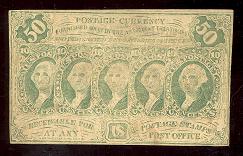
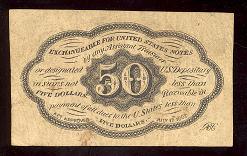
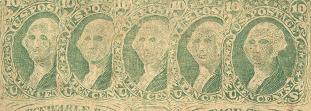
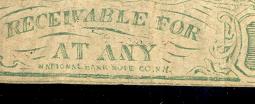
Here are two new important discovery notes of the 4th issue counterfeits that were recently found. CFT 1301 and CFT 1261 (small red seal). Both are unique being that they are the only one known for each variety that have been found at this time. Keep looking and you may find another examples.
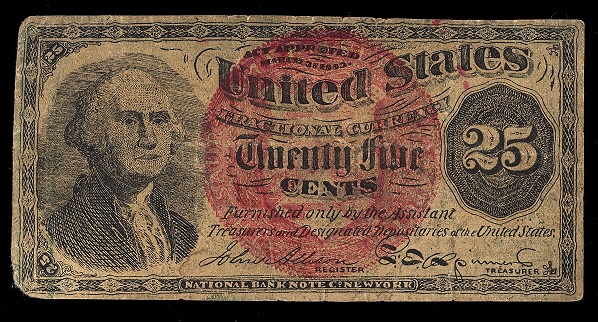
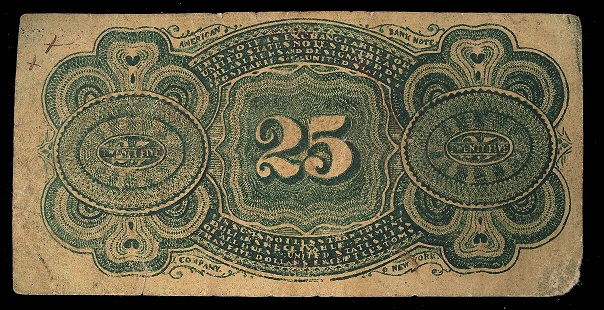
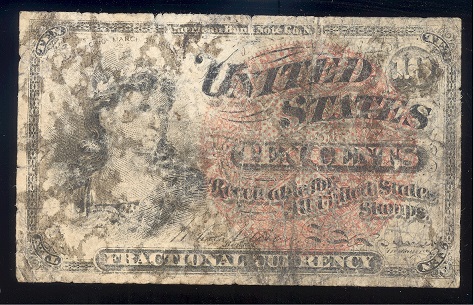
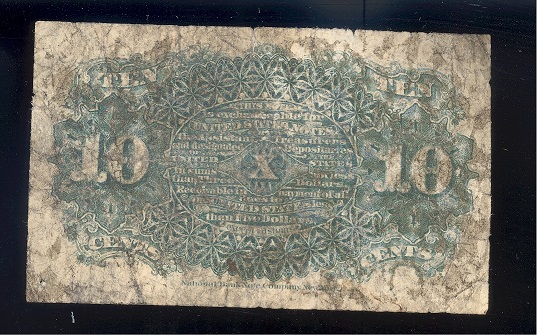
INVERTED PLATE NUMBER
I recently picked up a very nice looking Justice note on EBay. I used the 'Buy It Now' to purchase this nicely margined FR1366 note. These notes with widely spaced surcharges on their reverse are very difficult to find in high grade. I was pleased to win the auction but didn't know how pleased I would be until I got the note in the mail. The extra bonus to this note was that it had a partial plate number on the reverse. When looking at this number, it is hard to tell what the number it is. At first glance it looked like a '2' but as I looked at it again, something looked odd about this number. I contacted several fractional experts who thought it was a normal '2' but said it needed another millimeter of margin to tell for sure what the number is. After researching Heritage's archives for known inverted plate numbers to see the different styles that were used for the plate numbers, I became sure that I had something different than a normal '2'. After playing around with Photoshop, I was able to take a known inverted plate '32' and line it up with my partial plate number to get a perfect match. This note has now been attributed as being the only FR1366 with an inverted plate number. This number has been found on other Justice notes but this is the first for a FR1366.
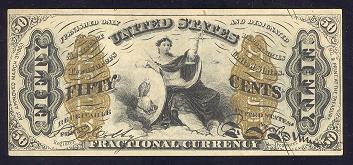
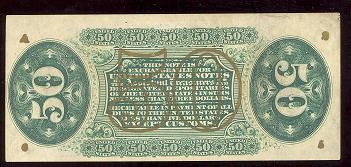
The next scan is the enlarged area of the partial plate number. The second scan is a known inverted plate number '32' and the last scan is where the first two scans are merged into one. Notice the perfect match.
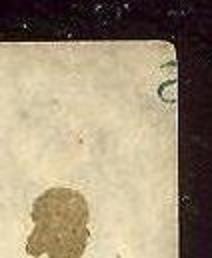
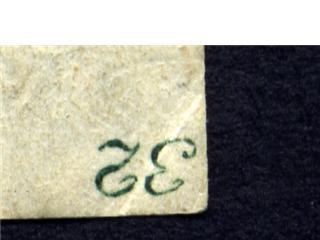
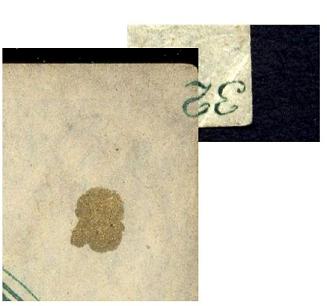
If you would like to know more, please read Rick Melamed's article on inverted plate numbers that is found in the Library section on this web site.
THE MISSING LINK (OR LOOP)
The Justice series of fractional currency comprises over thirty different varieties. This complex series was printed on two different papers, one being plain paper and the other being fiber paper. This series is also known for it's red and green printed reverses with several varieties of the red reverse having autograph signatures on the obverse. Bronze surcharges were also used on the red and green reverses to add different varieties. When the notes were printed, two design figures, '1' and 'a', were added to the printing plate. Because of these design figures, the Justice notes either have the '1,a', '1', 'a' or no design figures on them.
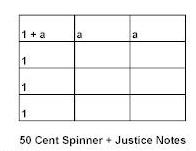
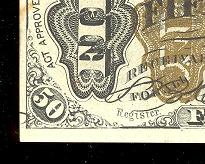
The normal layout for the printing plates for Justice and Spinner notes used a configuration for twelve notes per plate consisting of three columns of four notes. The top row of notes had the design letter 'a' in the lower left corner of each note and the left column used a design number '1' on the left side of each note in that column. (See figure on left) When the printing plates were engraved with Spinner's very flowing and distinctive signature, his signature loop extended onto the adjacent note to its right. Any note in the left column would not have this extended loop. Therefore, all '1,a' and '1' notes due to the layout on each plate would not have the extension of the signature loop. All other notes on the plate (with no design figures and design letter 'a') would have the extended loop on the left side of the note. (see note on right)
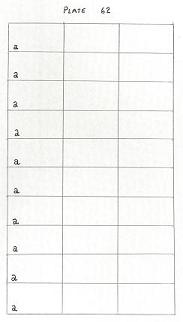
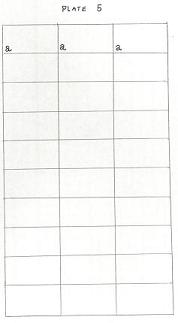
When Martin Gengerke researched and examined the plate proofs at the Bureau of Printing and Engraving, he found two plates, #5 and #62, that were of a different configuration. They were not of the usual 12 note layout but rather had a configuration of thirty notes. Each of these two plates had three columns of ten notes. What was different is that plate #62 used only a design letter 'a' in the left column and plate #5 used a design letter 'a' in just the top row. These two plates did not use design number '1' at all. This can be seen in figures to the left and right. Please remember that there would be no '1,a' notes from these two plates. When you add Spinner's flowing signature to these two plates, it is now possible that there would be a no-loop variety with the design figure 'a' if notes were printed from this plate. Also since plate #5 had no design figures in the left column, with the exception of the top left note, it is also possible that a no-loop variety exists for a Justice note with no design indicators on it. If any FR1362 or FR1365 note were found that didn't have the extended loop onto the left side of the note, it would have to come from one of these two plates. If an example of a no-loop FR1362 were found, it definitely would have come from plate #5. If an example of a FR1365 no-loop note were found, it would have come from either plate# 62 or #5. This is contrary to what would found on the normal plate layout.
The question of "Were these two plates ever used in the production of Justice notes?" has been answered. Two subvarieties of this series have been found which shows that these two plates were used in this specific series of Justice notes. This series consists of Friedberg numbers FR 1362-65. These notes were printed on plain paper with green reverses and compactly spaced surcharges of 'A,2,6,5' on its reverse. The FR 1362a is the no-loop variety with no design indicators. The FR 1365a is the no-loop variety with the design letter 'a' at the left of the note. To date, the 1365a has only three known examples with the one shown below which came from O'Mara's collection and it being the finest known and grades a nice AU. The 1362a also shown below is unique with only one known example being XF. The FR1362a could only come from plate #5. The FR1365a could have come from plate #5 but it is very unlikely that it did so. There are more known examples of the FR1365a, 3:1, than the FR1362a. Statistically, this suggests that it would have come from Plate #62. To be able to confirm that a note is the no-loop variety, it must have an adequate or ample left margin. Since the Justice notes were closely spaced to each other on each sheet and they were hand cut, many notes do not have enough margin on the left side to be able to accurately determine these two very rare varieties. Click on the below image to get full note.
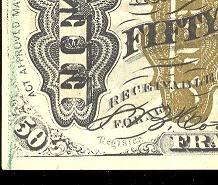 FR1362a no-loop
FR1362a no-loop
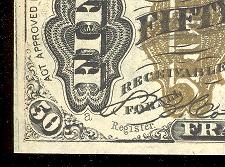 FR1365a no-loop
FR1365a no-loop
My gratitude and thanks to Michael Marchioni for obtaining this beautifully matched set of no-loop varieties for me which are now a part of my fractional collection.
RARE HAIR PIN VARIETY
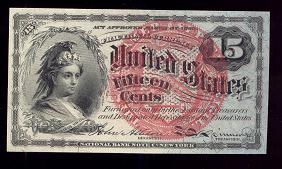
It has been some fifty years since a hair clip variety of the 15 cent Liberty fractional has been seen. This note has been verified by RCGS and has achieved a grade of Gem 66. The 'hairpin' can be seen just under and between the second and third star running from a 'ne to sw' in direction. This can be seen quite clearly when enlarging the image by clicking in the scan to the left.
This subvariety was first noted by Limpert in his List of 1947 on page 30 of his listing. "The outstanding rarity of D17, in my estimation, is when there is a 'clasp' shown from the second largest star of the coronet, going obliquely (ne to sw) over the hair to the brow above the right eye of the Vignette of Columbia. I mention the variety myself and am offering $25 for another one like it, just to acertain if there are any more around"
This note was sent to Rob Kravitz who verified that this was another example of the 'hair clasp' subvariety. On this example, there is no missing fiber in this area of the hair pin. I am guessing that this was not an intentional subvariety but is a result from a defect in the printing plate or printing process. Milt Friedberg included it in his numbering system as 4R15.4d.
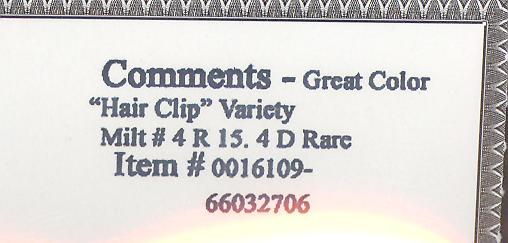
FRACTIONAL WALLET
An interesting item that I picked up recently that goes along with my fractional currency collection. I believe this wallet dates to the 1870's or 1880's. A fractional leather wallet that has compartments for 10C, 25C, 50C and large size notes. It looks to be in fairly good condition but has some scuffs and one scrape.
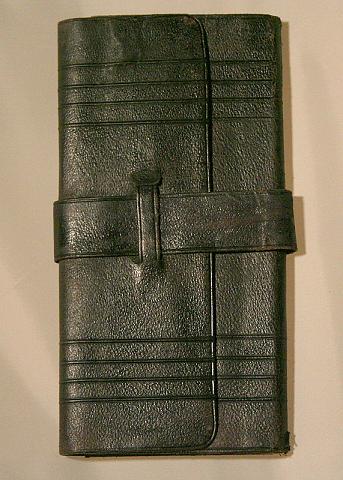
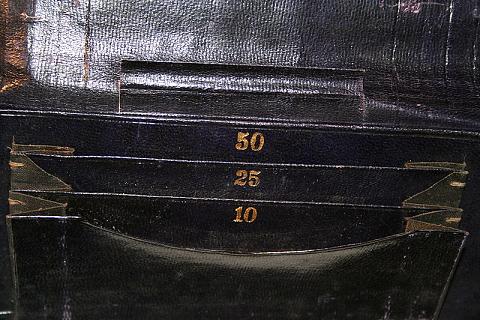
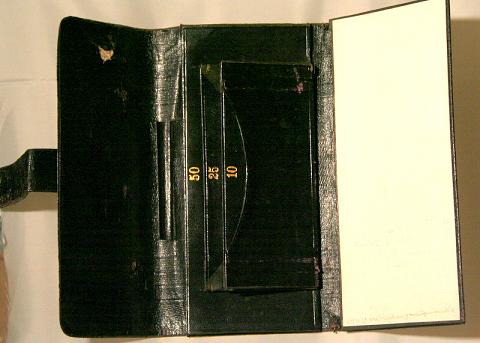
FRACTIONAL MATCH SAFES-NEW TO CENSUS
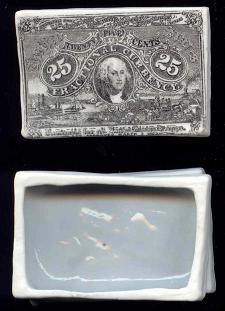
I just wanted to share a new addition to my fractional collection that I found on EBay. It is a match safe that depicts a second issue 25 cent note on its lid. According to an item description by Heritage in the O'Mara's sale, there are only about fifteen complete match safes and loose tops are a little more common with about forty lids still in existence. Heritage indicated that they have never seen a complete Second Issue match safe, but as you can see with the one I just received on EBay, it is a complete safe and it is in the style of a stack on notes. It may be unique by being the only complete 2nd Issue match safe.
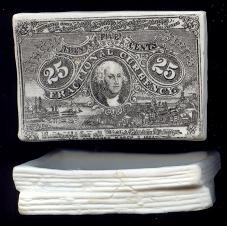
These match safes are very rare and were made by several different manufactures in several different designs. I have two complete safes, a 25 cent
safe and a Fressenden safe which is the most common with six complete examples. The O'Mara sale had three complete safes and two lids.
There is very little known about match safes and I have taken it upon myself to try to learn as much as possible about them. If you have one, I would appreciate a scan to show any styles of the box and also the design on the lid. If you just have the lid, a scan of the note on the lid would be nice to have too. All contact with me will be kept in confidence I will try to get a population for each style and report back with another article for our newsletter. If you have a complete match safe or just a lid, please contact me at dtreter@hotmail.com
SPINNER LETTER TO A COLLECTOR
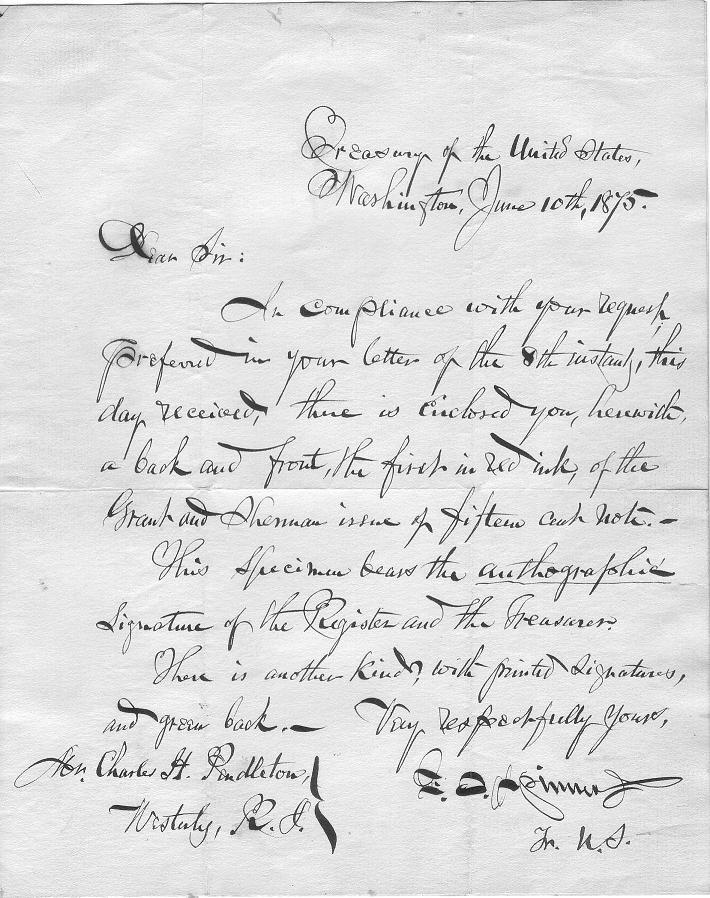
I wanted to share a letter that Spinner wrote to another collector that was recently sent to me. The scan of this manuscript is from a private collector who came into possession of the family document just recently. He has allowed me to share this scan with the FCCB members and my web site, myfractionalnotes.com. The letter is dated June 10, 1875 and was written to the Honorable Charles H. Pendleton of Westerly, Rhode Island. When I read the letter, it makes Spinner come alive. The penmanship is remarkable and you can almost feel his presence when you read his words. The remarkable thing is that Spinner infers in this letter that the autographed notes of fractional currency were meant to have the red backs and the more common printed signatures were to have the green back reverses. In reality, all autographed fractional currrency notes, with the exception of FR1255A, have the red reverses. Please take time to read and experience the wealth of history that is contained in this letter.